A well-designed garden is both functional and beautiful it’s not just about planting seeds, but about crafting a living space that thrives and reflects your vision.
A perfect layout allows plants to flourish, makes maintenance easier, and creates an outdoor haven that’s productive year-round.
If you’re ready to design smarter, these Garden Genius tips for a perfect layout will guide you every step of the way.
1. Start with a Vision

Before digging into the soil, spend time imagining what you want your garden to be. Are you planning a lush vegetable patch, a colorful flower haven, or a combination of both? Think about your goals: Do you want to grow food for your family, attract pollinators, or create a peaceful retreat?
-
Sketch your design on graph paper or use free garden planning apps.
-
Factor in elements like raised beds, trellises, or seating areas.
-
Consider how the garden will look through all four seasons.
A clear vision keeps your layout intentional, saving you from random planting that leads to overcrowding or wasted space.
2. Consider Sunlight and Shade
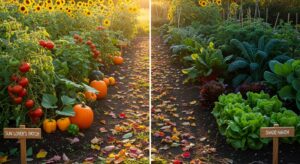
Sunlight determines which plants will thrive where. Most fruiting plants (like tomatoes, peppers, and cucumbers) need 6–8 hours of direct sun, while leafy greens like spinach and lettuce tolerate partial shade. Herbs such as mint and parsley also thrive with less sun.
-
Track your garden’s sun exposure at different times of day.
-
Use shade-tolerant plants to fill in dimmer areas.
-
Plant taller crops on the north side of the garden so they don’t block sun from shorter plants.
Designing with sunlight in mind ensures healthier growth and fewer disappointments.
3. Plan Pathways for Easy Access
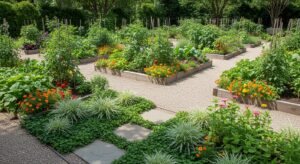
A genius garden layout isn’t just about the plants it’s also about how you move through the space. Pathways make it easier to water, weed, harvest, and admire your plants without compacting the soil.
-
Use gravel, stepping stones, or wood chips for durable paths.
-
Ensure pathways are at least 18–24 inches wide for comfortable movement.
-
Place paths strategically so you can reach every bed without stepping inside it.
Good access means less back-breaking work and healthier soil structure.
4. Use Companion Planting
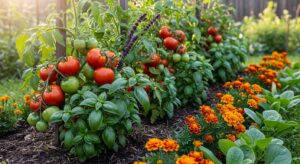
Companion planting is a natural way to boost productivity, reduce pests, and save space. By placing friendly plants together, you create mini-ecosystems within your garden.
-
Tomatoes + Basil: Basil repels pests and enhances tomato flavor.
-
Carrots + Onions: Onions deter carrot flies, while carrots loosen soil for onions.
-
Marigolds + Vegetables: Marigolds repel nematodes and add color.
This clever planting method not only improves harvests but also makes your layout more resilient and eco-friendly.
5. Think Vertical for More Space
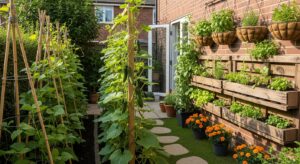
Vertical gardening transforms limited areas into abundant harvests. It adds depth, saves ground space, and keeps plants healthier by improving airflow.
-
Use trellises for cucumbers, beans, and peas.
-
Install wall planters or hanging baskets for herbs and flowers.
-
Create archways or vertical towers to grow squash or vining crops.
Vertical layouts aren’t just practical they add a striking design element that makes your garden visually stunning.
6. Group Plants by Watering Needs
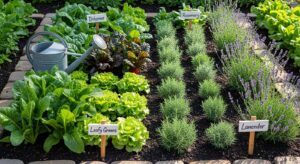
Water management is essential for any thriving garden. By grouping plants with similar water requirements, you avoid under- or over-watering.
-
Thirsty crops like cucumbers and lettuce should be placed together near your main water source.
-
Drought-tolerant plants like rosemary, thyme, or lavender can be grouped in drier spots.
-
Use drip irrigation or soaker hoses to save time and conserve water.
This method keeps your layout efficient, reduces waste, and helps plants grow more consistently.
7. Add Seasonal Flexibility
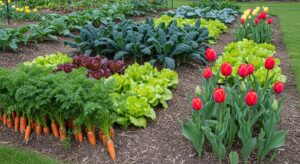
A garden genius doesn’t design just for summer they plan for every season.
-
Leave open sections for fall vegetables like carrots, kale, and beets.
-
Plant spring bulbs (like tulips and daffodils) around the edges for early color.
-
Rotate crops annually to improve soil fertility and prevent disease.
A flexible layout ensures that your garden remains productive and visually interesting all year instead of going dormant after one season.
8. Incorporate Aesthetic Features
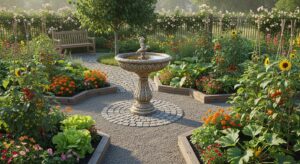
Your garden should be a place of joy as well as productivity. Adding design elements enhances both layout and experience.
-
Install focal points like a birdbath, garden bench, or small fountain.
-
Use raised beds with decorative borders for a neat appearance.
-
Mix colors and textures think purple basil alongside green lettuce or bright zinnias near tomatoes.
When beauty meets function, your garden becomes a space you’ll love spending time in, not just a place to work.
9. Prioritize Soil Health

The foundation of every great garden is its soil. A perfect layout includes easy access to maintain soil fertility and structure.
-
Enrich soil with compost, aged manure, or organic matter each season.
-
Rotate crops to avoid depleting the same nutrients.
-
Mulch garden beds to retain moisture, suppress weeds, and regulate temperature.
Healthy soil means stronger plants, fewer pests, and higher yields no matter how beautiful your layout looks on paper.
10. Keep It Simple and Practical
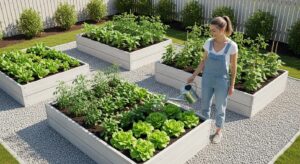
Above all, your garden should be manageable and enjoyable. Avoid cramming too many plants into one space or creating a layout that requires constant upkeep.
-
Start with a few beds and expand gradually.
-
Choose plants that fit your lifestyle low-maintenance herbs or perennials if you’re busy.
-
Focus on balance: a mix of productivity, beauty, and ease of care.
Simplicity is the true genius of a perfect garden layout one that brings joy without overwhelming you.
✅ Final Thoughts
Designing a garden layout takes planning, creativity, and a bit of strategy.
By following these Garden Genius tips, you’ll create a space that’s both practical and inspiring where pathways are clear, plants are healthy, and every season has something to offer.
A thoughtful layout not only makes gardening easier but transforms your outdoor space into a flourishing sanctuary you’ll treasure for years to come.
FAQs on Garden Layout
1. Why is garden layout important?
A good garden layout makes planting, watering, and harvesting easier while maximizing space and plant health.
2. How do I decide what to plant in my garden?
Start with your goals vegetables for food, flowers for beauty, or herbs for daily use and then match plants to your climate and sunlight.
3. Can I design a garden layout without professional help?
Yes! A simple sketch on graph paper or free online garden planning apps can help you map out a practical design.
4. How much sun should my garden get?
Most vegetables and flowers need at least 6–8 hours of sunlight per day. Shade-loving plants thrive in 3–4 hours.
5. What is companion planting and why is it useful?
It’s the practice of pairing plants that benefit each other for example, basil deters pests around tomatoes, while marigolds repel nematodes near vegetables.
6. How can I save space in a small garden?
Vertical gardening using trellises, hanging planters, and towers helps maximize limited space.
7. Should I group plants by water needs?
Yes placing thirsty plants together and drought-tolerant ones elsewhere saves water and prevents inconsistent growth.
8. How can I make my garden productive year-round?
Leave space for crop rotation, plant seasonal vegetables, and use row covers or cold frames to extend growing time.
9. Do pathways really matter in garden design?
Absolutely. Pathways prevent soil compaction, make beds accessible, and keep the layout neat and functional.
10. What’s the biggest mistake to avoid in garden layout?
Overcrowding and overcomplicating the design. A simple, practical plan is more successful and enjoyable long-term.